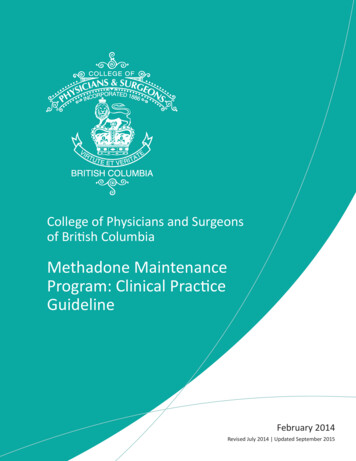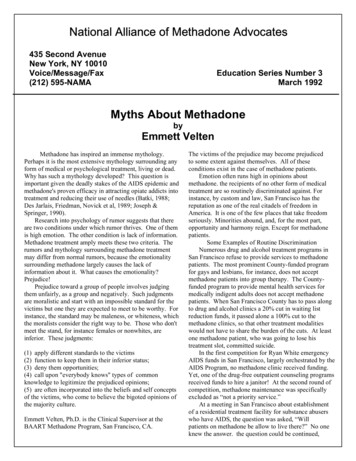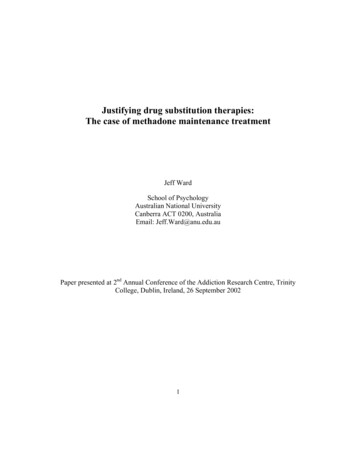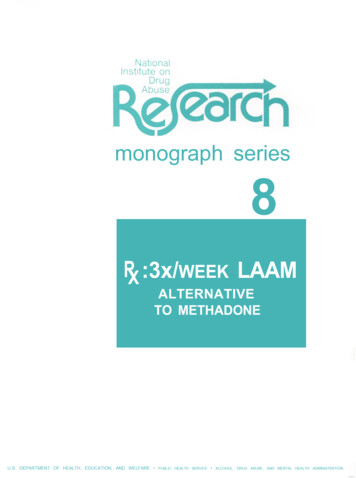
Transcription
Methadone-Drug* Interactions(*Medications, illicit drugs, & other substances)Stewart B. Leavitt, MA, PhD; Executive Director, Pain Treatment Topics; January 2006Reviewed but not revised June 2010Medical Reviewers: James D. Toombs, MD; Lee Kral, PharmD, BCPSPrior Publication History3rd Edition: November 2005 Revision/Update, Addiction Treatment Forum Special Report, ATForum.com.Researcher/Writer:Stewart B. Leavitt, PhD, Editor, Addiction Treatment ForumMedical Reviewers:R. Douglas Bruce, MD, MA; Yale AIDS Program, Yale University School of Medicine; New Haven, CT.; Chin B. Eap,PhD, Biochemistry and Clinical Psychopharmacology, University Department of Adult Psychiatry; Cery Hospital,Prilly-Lausanne, Switzerland; Evan Kharasch, MD, PhD; Professor and Director, Clinical Research Division,Department of Anesthesiology; Washington University, St. Louis, MO; Lee Kral, PharmD, BCPS; Center for PainMedicine and Regional Anesthesia; University of Iowa Hospitals and Clinics; Iowa City, IA; Elinore McCance-Katz,MD, PhD, Chair, Addiction Psychiatry; Medical College of Virginia, Virginia Commonwealth University, Richmond,VA; J. Thomas Payte, MD; Corporate Medical Director; Colonial Management Group; Orlando, FL.2nd Edition: January 2004, Addiction Treatment Forum Special Report.Researcher/Writer:Stewart B. Leavitt, PhD, Editor, Addiction Treatment ForumMedical Reviewers:Chin B. Eap, PhD, Prilly-Lausanne, Switzerland; John J. Faragon, PharmD, RPh, Albany, NY;Gerald Friedland, MD, New Haven, CT; Marc Gourevitch, MD, Bronx, NY;Elinore McCance-Katz, MD, Richmond, VA; J. Thomas Payte, MD, Orlando, FL.1st Edition: Published as, Leavitt SB. Methadone at work. Addiction Treatment Forum. 1997(Spring);6(2). Copyright Pain Treatment Topics (SBL Ltd) 2006-2010
Methadone-Drug Interactions, Page 2Pain-Topics.orgSection ContentsUnderstanding Methadone Metabolism & Drug Interactions The Importance of Drug Interactions Methadone History Metabolic Basics Methadone Metabolism Methadone-Drug Interactions Putting Concepts Into Practice Finding Drugs/Substances of Interest in this DocumentTable Abbreviations, Data Sources, NotesTable 1: Drugs That Are CONTRAINDICATEDwith Methadone (May Precipitate Opioid Withdrawal)Table 2: Drugs That May Result in Altered Metabolism orUnpredictable Interactions with MethadoneTable 3: Drugs That May LOWER SML and/or DECREASEMethadone EffectsTable 4: Drugs That May RAISE SML and/or INCREASEMethadone EffectsTable 5: Methadone-Drug Interactions: Alphabetical Listingby Generic & Brand NamesTable 6: Drug Interactions Resources on the InternetReferences
Pain-Topics.orgMethadone-Drug Interactions, Page 3The Importance of Drug InteractionsEach year in the U.S. there are innumerableadverse drug reactions, broadly defined as anyunexpected, unintended, undesired, or excessiveresponse to a medicine. Such reactions may requirediscontinuing or changing medication therapy.Furthermore, greater than 2 million of those areserious reactions resulting in hospitalization and/orpermanent disability, and there are more than 100,000deaths annually attributed to reactions involvingprescribed medications (Cohen 1999; Wilkinson2005).Three-fourths of those adverse reactions relate to drug interactions, which occur when theamount or action of a drug in the body is altered – usually increased or decreased – by the presenceof another drug or multiple drugs (Bochner 2000; Levy et al. 2000; Piscitelli and Rodvold 2001).Avoiding these can be difficult, since the number of potential interactions among diverse drugs used inclinical practice can be overwhelming; more than 2,000 such interactions have been described in theliterature and new cases appear monthly (Levy et al. 2000). As the tables in this document indicate,there are more than100 substances – medications, illicit drugs, OTC products, etc. – that can interactin some fashion to affect a patient ’s response to methadone.Pharmacotherapy is increasingly complicated by the introduction of new drugs and the use ofmultidrug regimens – called “polypharmacy ” – for acute or chronic disease, which can result inclinically important drug interactions. While multiple drugs often are necessary for treating complex orresistant conditions, side effects of the drugs themselves may induce symptoms rather than anypathological processes (Farrell et al. 2003). This is of vital importance for patients receivingmethadone analgesia regimens, since these individuals often have co-morbid physical and/or mentaldisorders requiring multiple medications.Methadone HistoryMethadone was discovered in Germany in the late 1930 ’s by Max Bockmühl and Gustav Ehrhart,working for the German chemicals conglomerate IG Farberindustrie. They were exploring syntheticcompounds with a structure similar to Dolantin , which was an opioid analgesic (later marketed asPethidine , Demerol , and others) similar to morphine that was discovered earlier at the samecompany (Bäumler 1968, Chen 1948; Ehrhart 1956; Eichler and Farah 1957; Erhart and Ruschig1972; Payte 1991; Preston 2003).
Pain-Topics.orgMethadone-Drug Interactions, Page 4Bockmühl and Ehrhart synthesized a compound that was both analgesic and spasmolytic, whichthey called “Hoechst 10820 ” and for which they filed a patent application in September 1941. Thisagent was found to be at least as powerful as morphine and 10 times more potent than Dolantin;however, its pharmacology was different and little was known about how to best prescribe the newagent. Consequently, Hoechst 10820 was not effectively used as an analgesic during the war years,allegedly because the very high initial doses typically administered at that time produced intolerableside effects (Bäumler 1968, Chen 1948; Ehrhart 1956; Eichler and Farah 1957; Erhart and Ruschig1972; Payte 1991; Preston 2003).As part of the “spoils of war, ” the formula for Hoechst 10820 became available to other countriesworldwide and was further tested and used for analgesia. It soon became generically known asmethadone and trade names in the U.S. include Dolophine and Methadose ; other brands havebeen developed outside the U.S. (Bäumler 1968, Chen 1948; Eichler and Farah 1957; Ehrhart 1956;Erhart and Ruschig 1972; Payte 1991; Preston 2003; Velten 1992).Initially, methadone was widely used in clinical medicine as an analgesic and antitussive, forwhich it was approved in the U.S. in 1947. Early indications for its use included: migraine,dysmenorrhea, labor pain, painful nerve disorders, advanced cancer or tuberculosis, and tetanus,among others. However, at this time, relatively little was known about methadone pharmacology andhow best to prescribe it. Due to improper prescribing and/or misuse, there were deaths associatedwith methadone in the late 1940 ’s and the 1950 ’s, and a number of those fatalities were reported inEngland and Germany among young children exposed to methadone in cough syrups. Similar deathsin children and adults, or cases of near-fatal respiratory depression, soon occurred in other countrieswhere methadone was widely prescribed. Consequently, due to its perceived toxicity and the potentialfor methadone to produce physiologic dependence, it fell into disuse as an analgesic by the early1960 ’s (Harding-Pink 1993; Payte 1991; Preston 2003; Rettig and Yarmalonsky 1995).In the mid-1960 ’s, Vincent P. Dole, MD, and his team at Rockefeller University in New York Citybegan research on a new method for treating heroin addiction. Methadone was chosen forexperimentation in treating opioid addicts because it was known to be long-acting, could be takenorally, and had been previously used in analgesia and for withdrawing opioid-addicted persons fromheroin. Dole and colleagues found that, once opioid tolerance was established to a methadone doseof 80-120 mg/day, patients were able to function normally, without drug craving (Dole 1988; Josephand Appel 1993; Joseph et al. 2000; Kreek 1993; McCann et al. 1994; Nadelman and McNeely 1996;Parrino 1993).During clinical use in the maintenance treatment of opioid addiction spanning more than 40 years,hundreds of studies have examined the pharmacology and efficacy of oral methadone and it hasproven to be a well-tolerated medication with minimal adverse reactions when properly prescribed inappropriate doses (Kreek 1973; Novick et al. 1993). However, there are potential methadone-druginteractions – involving other prescribed medications, illicit drugs, OTC products, and othersubstances – which sometimes can be difficult to predict. Such interactions may be potentially harmful
Pain-Topics.orgMethadone-Drug Interactions, Page 5and/or can lead to treatment failures, whether methadone is used as a component of addictiontreatment or as an analgesic (Harrington et al. 1999; Levy et al. 2000).Metabolic BasicsMost drugs are foreign to the human body and are metabolized by chemical reactions intomolecules that can be more easily eliminated (Flexner and Piscitelli 2000). A primary metabolicpathway involves the actions of proteins, called cytochrome P450 (CYP450) enzymes, that facilitatethose chemical reactions. These enzymes evolved as a protective mechanism more than 3 billionyears ago to cope with a growing number of naturally occurring environmental chemicals and toxins(Hardman et al. 1996; Richelson 1997).There are more than 28 CYP enzymes encoded by 57 different human genes (Flexner andPiscitelli 2000; Shannon 1997; Wilkinson 2005). Each is designated by a combination of numbers andletters: for example, 3A4 and 2B6 which are important in methadone metabolism. CYP enzymesreside mainly in the liver, but also are present in other organs. Substances that interact with theCYP450 system usually do so in one of three ways: 1) by acting as a substrate, 2) through inhibition,or 3) through induction. A substrate is any drug metabolized by one or more CYP enzymes, and more than half of allmedications that undergo metabolism are CYP3A4 substrates (Piscitelli and Rodvold, 2001). Some drugs are inhibitors of specific CYP enzymes and thereby slow the metabolism ofdrugs that are substrates for those particular enzymes, which may result in excessively highdrug levels and related toxic effects (Levy et al. 2000). Other drugs are inducers; they boost the activity of specific CYP enzymes resulting in morerapid metabolism of substrate drugs, which may result in lower than expected levels of thesubstrate drugs (Flexner and Piscitelli 2000).A drug can at the same time be a substrate for and induce or inhibit one or more CYP enzymes.Co-administered drugs that merely share the same metabolic pathway – that is, are substrates for thesame CYP enzymes – may compete with each other. The “winning drug ” could garner more enzymeactivity, thus diminishing metabolism of the other drug and intensifying its effects (Hardman et al.1996). Readers may wish to consult current sources listing drugs that are CYP450-enzymesubstrates, inducers, or inhibitors; such as at http://drug-interactions.com (Flockhart 2003).Methadone MetabolismMethadone is usually readily absorbed, with about 80% of the administered dose passing into thebloodstream during stabilized, steady-state dosing and the remainder metabolized in the GI tract andliver; although, for reasons described below, bioavailability can range from 35% to 100% (Eap et al.2002, Moolchan et al. 2001). The three available formulations of oral methadone – solid tablets,dispersible tablets, and liquid concentrate – have been demonstrated as intrinsically equal in terms oftheir bioavailability and metabolism (Gourevitch et al. 1999); however, patient reactions to eachformulation may vary, possibly due to psychosomatic factors in some cases.
Methadone-Drug Interactions, Page 6Pain-Topics.orgThe most important enzymes in methadone metabolism are CYP3A4 and CYP2B6. SecondarilyCYP2D6 appears to have a role, and CYP1A2 may possibly be involved (see Table).CYP450 Enzymes Metabolizing MethadoneCYP3A4Important methadone metabolizer (can also be induced by methadone during theearly start-up phase of therapy).CYP2B6Relatively recently discovered as an important methadone metabolizer.CYP2D6Secondary role (methadone can inhibit this enzyme in some cases and this enzyme isparticularly involved in the metabolism of the active R-methadone enantiomer).Possibly involved (clinical significance still under investigation).CYP1A2Note: Previously CYP2C9 and 2C19 were thought to be involved, but this has not been confirmed (Crettol et al. 2005).Borg and Kreek 2003; Eap et al. 2002; Gerber 2002; Gerber et al. 2004; Iribarne et al. 1997; Kharasch et al. 2004a;Leavitt et al. 2000; Moolchan et al. 2001; Shinderman et al. 2003; Wu et al. 1993CYP3A4, the most abundant metabolic enzyme in the body, can vary 30-fold between individualsin terms of its presence and activity in the liver (Eap et al. 2002; Leavitt et al. 2000). This enzyme alsois found in the gastrointestinal tract, so methadone metabolism actually can begin before the drugenters the circulatory system (Hardman et al. 1996). The amount of this enzyme in the intestine canvary up to 11-fold, partially accounting for some individual differences in the breakdown andabsorption of methadone (Levy et al. 2000).Fairly recently, CYP2B6 has been discovered as playing a prominent role in methadonemetabolism (Gerber 2002; Gerber et al. 2004; Kharasch et al. 2004a, Rotger et al. 2005), andespecially but not exclusively metabolism of the inactive S-enantiomer (Crettol et al. 2005, in press;Totah et al. 2004). Effects of CYP2B6 were demonstrated in laboratory experiments and also helpedaccount for certain otherwise unexplained methadone-drug interactions during human trials. Atpresent, relatively few agents have been identified as inducers or inhibitors of CYP2B6 (Faucette etal. 2004; Flockhart 2005), and there also can be individual differences in activity of this enzyme(Kharasch et al. 2004a; Rotger et al. 2005). However, as research continues, many agents currentlythought to be interacting with methadone primarily via other P450 enzymes also may be identified asCYP2B6 substrates, inducers, or inhibitors. Therefore, in many cases, the most that can be statedwith certainty at present is that CYP450 enzymes are involved in a methadone-drug interaction,without always knowing the relative roles of exact enzymes (personal communication, E. Kharasch,October 2005).Another metabolic protein of some importance is P-glycoprotein (P-gp), which is found in theintestine, along the blood-brain barrier, and in other tissues (Matheny et al. 2001, Wang et al. 2004).This substance functions as a pump, transporting methadone out of cells lining the intestinal wall andback into the lumen. Thus, some of the methadone absorbed by the intestine is pumped back outbefore it ever enters the circulation. There is up to a 10-fold variation in the amount of intestinal P-gpexpressed by individuals (Hall et al. 1999, Leavitt et al. 2000), and some interactions originallyconsidered solely due to intestinal CYP3A4 may involve P-gp as well (Dresser et al. 2000; Eap et al.2002; Kharasch et al. 2004b). Some evidence suggests that expression of P-gp in the blood-brain
Pain-Topics.orgMethadone-Drug Interactions, Page 7barrier, which can vary across individuals, may play a role in the access and effects of methadone inthe brain and the potential for adverse effects (Wang et al. 2004). Although, one clinical study foundthat P-gp may not be a significant factor in this regard (Kharasch et al. 2004b).Drugs or other agents that induce the activity of enzymes involved in methadone metabolism canaccelerate its breakdown, increase its rate of clearance, abbreviate the duration of methadone ’seffects, lower the serum methadone level (SML), and possibly precipitate opioid-withdrawalsyndrome. Conversely, CYP-enzyme inhibitors may slow methadone metabolism, raise the SML,extend the duration of its effects, and possibly cause methadone-related toxicity such as oversedationand/or respiratory depression (Eap et al. 2002; Leavitt et al. 2000; Methadose PI 2000; Payte et al.2003; Wolff et al. 2000).Genetic factors also can act on certain enzymes to affect methadone metabolism. For example,CYP2D6 is entirely absent in a significant portion of the population (1 out of 15 persons), resulting inincreased sensitivity to methadone ’s effects; conversely, some persons have high activity of thisenzyme and are rapid metabolizers of methadone (Eap et al. 2002).The variability of CYP-enzyme presence and activity means that SMLs can differ significantlyeven in the absence of interacting substances; some persons can naturally be either extensive (rapid)or poor (slow) metabolizers of methadone. When interactions with other drugs occur on top of this itcould further influence problematic methadone under- or overmedication (Eap et al. 2002; Leavitt etal. 2000; Richelson 1997).Methadone-Drug InteractionsWhen co-prescribing medications with methadone, and a suspected drug interaction occurs, thetime course of sign/symptom development can be a guide as to whether enzyme induction orinhibition is involved. Overmedication reactions are likely due to CYP inhibition that develops quickly;within a few days after concurrent drug administration. In contrast, CYP induction is slower to emerge,commonly taking about a week to produce significant withdrawal signs/symptoms (Antoniou andTseng 2002; Faragon and Piliero 2003; Gourevitch and Friedland 2000; Hansten 1995; Wolff et al.2000). In the presence of strong CYP inducers, merely increasing the methadone dose may beinsufficient and an increase plus more frequent daily dosing may be necessary.Potential effects on methadone metabolism also should be considered when discontinuingmedications. If a drug that inhibits CYP enzymes is stopped, methadone serum levels may decreaseand cause opioid withdrawal that requires increased methadone dose. Conversely, if a CYP inducer isdiscontinued, metabolizing-enzyme levels will diminish and SMLs may rise to toxic levels unlesscareful methadone dose reductions are implemented in response to clinical signs of overmedication.Some methadone-drug interactions primarily relate to how certain drug combinations mayadversely affect physiological response in the patient (pharmacodynamics) and have little to do withaltered pharmacokinetics. For example, the additive effects of methadone combined with other centralnervous system (CNS) depressants may cause hypotension, sedation, respiratory depression, or
Pain-Topics.orgMethadone-Drug Interactions, Page 8coma (Leavitt 2003; Methadose PI 2000). Also, polysubstance abuse in certain patients may put themat greater risk of adverse additive interactions with other CNS-active drugs (Antonio and Tseng 2002;Harrington et al. 1999; Quinn et al. 1997).Another concern involves the recognition of methadone ’s potential to affect heart rhythm undercertain circumstances (Leavitt and Krantz 2003). Researchers studying patients attending methadonemaintenance programs for addiction have reported relatively small but statistically significant QTinterval increases; however, the QT measurements generally remained within acceptable limits(Maremmani et al. 2005; Martell et al. 2005). Often, these heart rhythm changes were in patientstaking medications or drugs in addition to methadone, or having cardiac risk factors that mightnormally be of concern (Leavitt and Krantz 2003).In the largest retrospective investigation to date, researchers examined all adverse eventsassociated with methadone officially reported to the FDA during a 33 year period (Pearson andWoosley 2005). Of 5,503 incidents, only 16 noted QT interval prolongation and 43 indicated torsadede pointes (TdP). Most cases involved methadone used in pain management – at doses ranging from29 to 1,680 mg/day – and it could not be determined that methadone was a direct cause. Five cases(0.09%) were fatal; however, 3 of those involved pre-existing factors known to influence arrhythmia.The conclusions and recommendations of all major investigations to date concur that the risk ofTdP is likely to be small, should not deter healthcare providers or patients from using methadone, andit is premature to suggest routine ECGs before or during methadone therapy. However, it would beadvisable to take careful medical histories screening for known cardiac risk factors and it would beprudent not to co-prescribe methadone with other drugs known to prolong the QT interval because ofthe potential for additive effects (Krook et al. 2004; Leavitt and Krantz 2003; Maremmani et al. 2005;Martell et al. 2005; Pearson and Woosley 2005; Piquet et al. 2004). Thus, comedications that mightproduce acute elevations of serum methadone concentrations or may in themselves contribute todysrhythmias should be used only after considering the risks versus benefits.In cases of patients on elaborate drug regimens – such as multidrug therapies for HIV/AIDS,hepatitis, and/or severe mental illness – outside consultation with specialists in suchpharmacotherapies might be advised. For example, many drugs used for HIV/AIDS therapy interactwith each other (Chrisman 2003; Schütz 2002) and their combined effects on methadone can becomplex (Antoniou and Tseng 2002; Faragon and Piliero 2003).Putting Concepts Into PracticeMethadone works best when administered in adequate therapeutic doses (Leavitt 2003).However, given the individual variability in methadone absorption and metabolism, it becomes difficultto accurately predict the effects of drug combinations in any one patient (Harrington et al. 1999), orhow methadone dosing may need adjustment to compensate for metabolic inducers or inhibitors(Wolff et al. 2000). If a patient is responding unexpectedly or unfavorably to methadone – withsigns/symptoms of under- or overmedication – a search for potentially interacting substances
Methadone-Drug Interactions, Page 9Pain-Topics.org(prescribed medications, illicit drugs, OTC products, or other agents) would be appropriate. Taking acomprehensive history from the patient can be important in this search (Kramer 2000).When prescribing comedications the potential for certain drugs and drug combinations to interactwith methadone requires careful consideration. Furthermore, polysubstance abuse may place patientsat risk for hazardous interactions of methadone with other opioids and drugs such as alcohol, cocaine,barbiturates, and benzodiazepines. Clinical experience, intuition, and common sense can be valuabletools for practitioners in taming drug interactions and the following Table lists some suggestions.Clinical Suggestions for Minimizing Methadone-Drug Interactions1. Maintain an accurate, updated profile for each patient that includes all prescribed drugs and OTCproducts (including herbal remedies and dietary supplements).2. Use alternative, non-interacting, drugs whenever possible.Usually, there are differences in the interactive properties of at least some members of any drug class. Forexample, the macrolide antibiotic erythromycin is a strong CYP3A4 inhibitor, likely to possibly interact withmethadone, whereas the macrolide azithromycin does not appear to have this effect.3. If a potentially interacting drug is used with methadone, it is better to adjust the methadone dosebased on patient response rather than in advance based on an expected interaction.The magnitude of drug interactions varies dramatically from patient to patient, and it is unlikely that theselected methadone dosage adjustment would exactly offset the actual effect of the second drug.4. Signs/symptoms of either opioid withdrawal or overmedication (e.g., sedation), and their severity,can help gauge serum methadone level (SML) adequacy in the presence of an interacting drug.Adjustments of methadone or concomitant drug(s) may be appropriate to overcome such adversereactions.5. If there are concerns about adverse effects of increased methadone concentrations, patientsshould be advised in advance of physical signs/symptoms of overmedication that might occur andwhat to do. It may be desirable to temporarily monitor SMLs in certain cases.6. Whenever possible, avoid concurrent administration of drugs with overlapping adverse-effectprofiles. Otherwise, signs/symptoms of major variations in methadone concentration may beconfused with side effects of concomitantly administered drugs, and vice versa.7. Consider preexisting disease states.For example, conditions associated with impaired renal or hepatic function may significantly alter drugmetabolism and excretion. Patients with preexisting cardiovascular conditions – particularly those withcongestive heart failure or left ventricular systolic dysfunction – may be more sensitive to potentialarrhythmogenic effects of certain drugs (including methadone).8. In some cases, adverse drug reactions can be resolved by prescribing a medication with or withoutfood, by altering dosing schedules, or by splitting doses into smaller increments.9. Unreported or seemingly inconsequential factors may play a role in drug interactions.For example, grapefruit juice can hinder metabolism and increase methadone serum levels.10. Patients may not adhere to prescribed medication regimens, which could affect adverse reactions,and the more complicated the regimen the less likely that the patient will adhere to it. This can beimportant in methadone-maintained patients prescribed multiple medications.Adapted from: Chung 2002; Cohen, 1999; Kramer 2000; Levy et al., 2000; Piscattelli and Rodvold, 2001
Methadone-Drug Interactions, Page 10Pain-Topics.orgThe traditional advice when adding drugs to a therapeutic regimen is to start low, go slow, andmonitor closely. This may be especially prudent with methadone analgesia, since many commonlyprescribed drugs are associated with dose- and concentration-dependent toxicities, and individualresponse may vary by several orders of magnitude. Potential adverse reactions also can beminimized by using the smallest effective doses for drugs added to methadone therapy. In manycases, doses of adjunctive medications lower than those recommended by the manufacturer may besufficient for desired therapeutic effect (Cohen, 1999).It has long been recognized that patient education is essential for successful outcomes withmethadone and this should be initiated early in treatment. Better informed patients can partner moreeffectively with clinic staff regarding their pharmacotherapy. However, as with all other aspects of painmanagement, this relies on mutual trust and effective communication. Several important points needto be emphasized with patients regarding potential interactions of methadone with other substancesand to help them avoid all drug interactions, as noted in the Table below.Helping Patients Avoid Drug Interactions Patients maintained on methadone should be cautioned to consult healthcare professionals beforetaking any OTC products, herbal remedies, or dietary supplements. Patients should provide to their healthcare providers and pharmacist an updated list of all medicalproducts used. Patients should understand their prescriptions and the dosage, and be able to cross-check whatwas prescribed with what they receive from the pharmacist. For each prescribed medication, patients should be verbally instructed on what the drug is used for,how to take it, and how to reduce the risk of side effects or drug interactions. It cannot be assumedthat patients will read or understand product labels or written information provided with medicationsor other healthcare products. Compliance with prescribed medication regimens should be emphasized. Patients need tounderstand the importance of taking all medications exactly when, how, and in the quantitiesspecified. Patients should be educated on the hazards of taking excess medication or sharing medicines withanyone else. They should be reminded about safe storage of medications and proper disposal ofunused portions. Patients should be counseled on the importance of quickly reporting any sudden or unexpectedsigns/symptoms of either methadone withdrawal or overmedication, as this could indicate apotentially hazardous interaction with another drug or substance. Special consideration and instruction will be required for patients with physical conditions that maycause or exacerbate drug interactions, such as: liver or kidney disorders, pulmonary or heartailments, pregnancy, etc. Patients taking multiple medications should be assisted in keeping a journal or chart listing thename, purpose, and dose schedule for each drug. Patients should be instructed in advance on what to do in the event of an emergency if their supplyof methadone and/or other medications runs out and they do not have access to their usual sourceof supply. Ideally, such instructions also would be provided in writing.Adapted from: FDA/CDER 2000; NCPIE 2003.
Pain-Topics.orgMethadone-Drug Interactions, Page 11Theoretically, any drug or substance metabolized by the same CYP enzymes as methadone, oraffecting their expression by inhibition or induction, might interact with methadone; although, many ofthese interactions would not be clinically important. Just because certain drugs can interact does notmean that they will, or to what extent.The methadone-drug interaction Tables below list only drugs and substances specificallymentioned in the scientific literature that either: A) should definitely be avoided with methadone, B)may influence unexpected results or are themselves altered by their combination with methadone, orC) raise or lower SMLs and increase or decrease methadone ’s effects, respectively. Due to spacelimitations, earlier editions of this document most extensively cited literature-review articles inreporting sources of information. This current document retains those references but is greatlyexpanded to also include citations of the primary studies and articles.There
The most important enzymes in methadone metabolism are CYP3A4 and CYP2B6. Secondarily CYP2D6 appears to have a role, and CYP1A2 may possibly be involved (see Table). CYP450 Enzymes Metabolizing Methadone CYP3A4 Important methadone metabolizer (can also be induced by methadone during the early start-up phase of therapy).










